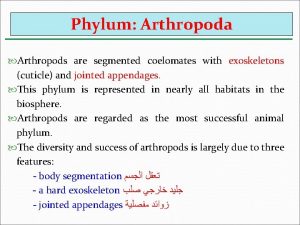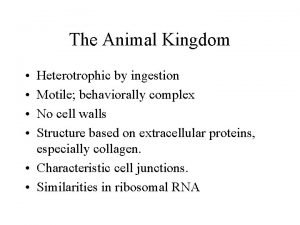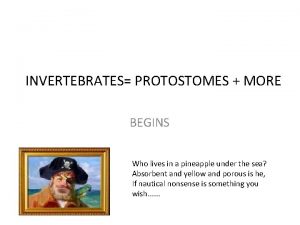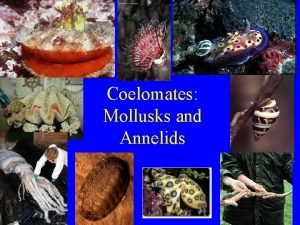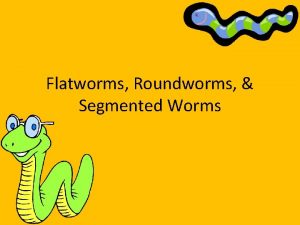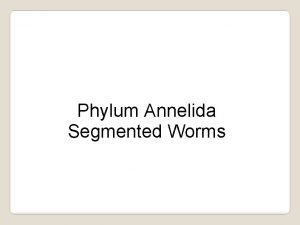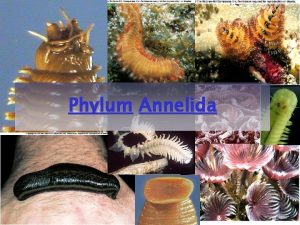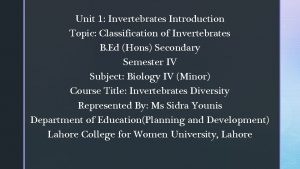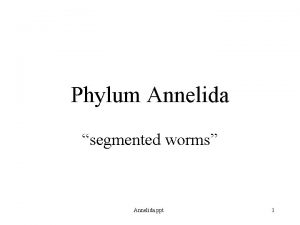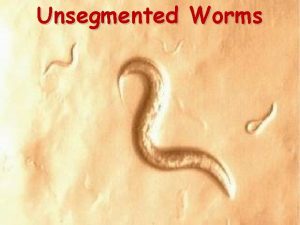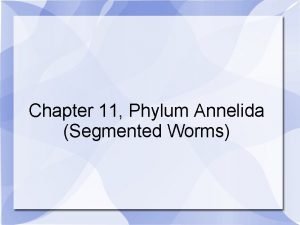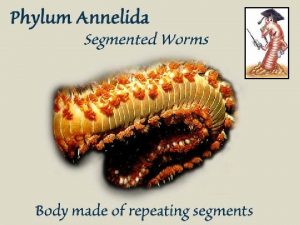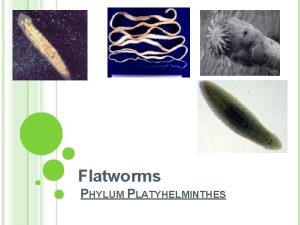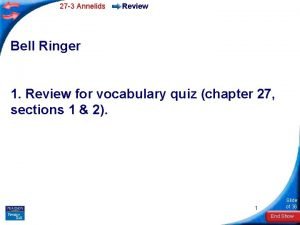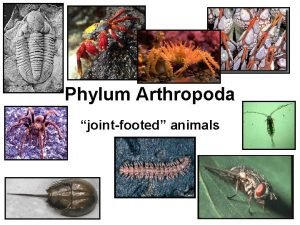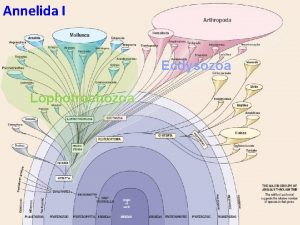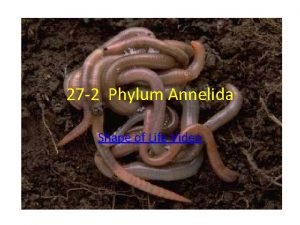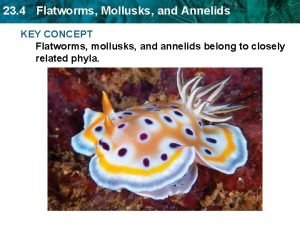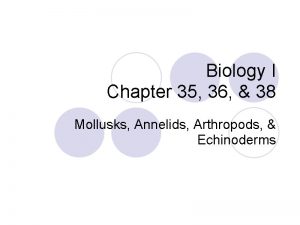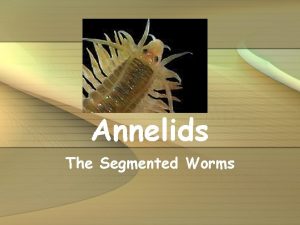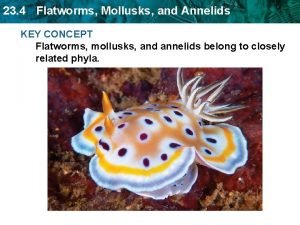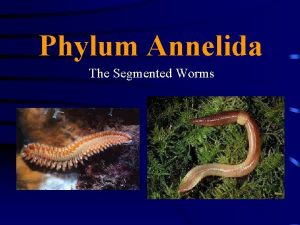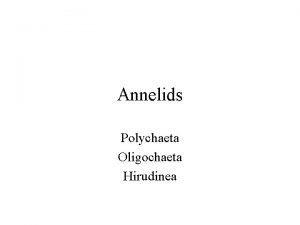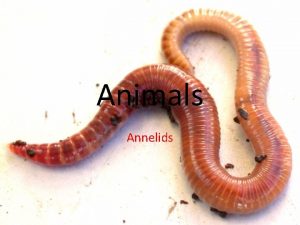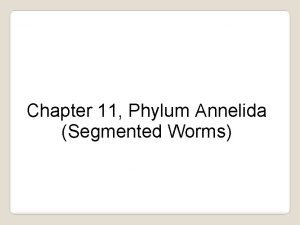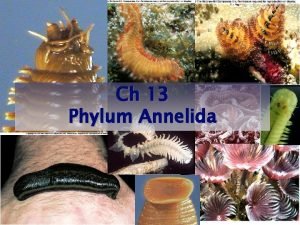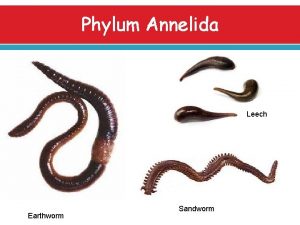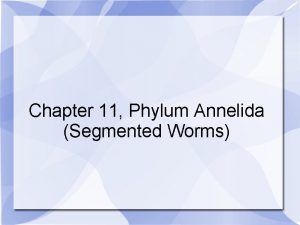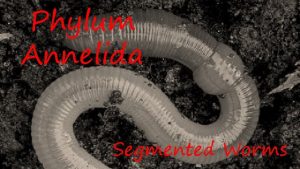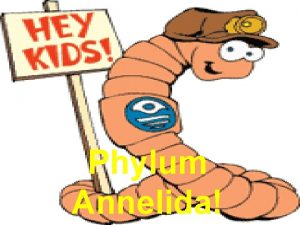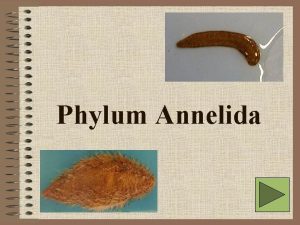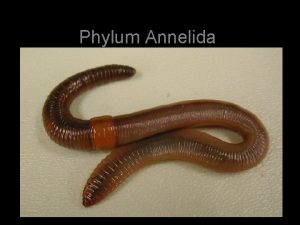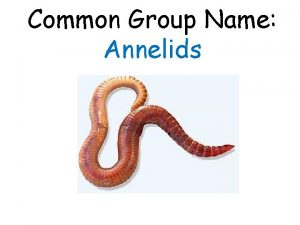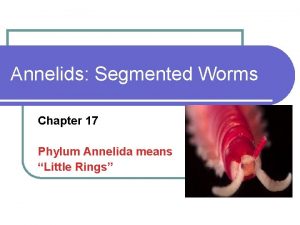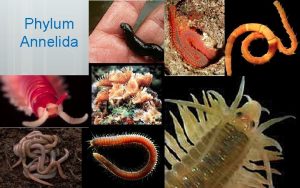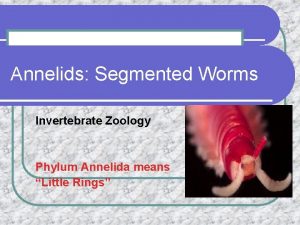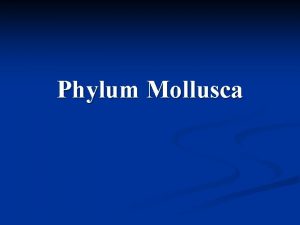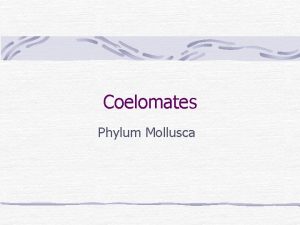Coelomates Phylum Annelida The Annelids Phylum Annelida w


























- Slides: 26

Coelomates Phylum Annelida The Annelids

Phylum Annelida w Coelomates – they have a true body cavity w Protostomes w Bilateral Symmetry w Triploblastic ( 3 embryonic tissue layers) w Segmented worms n Review Segmentation from Chap. 31

Annelids: Common Features Septum Segments = Metameres w The body is divided into segments called metameres w The coelum ( internal body cavity) is divided into individual chambers by crosswalls called septa

Annelids: Common Features Setae (bristles) n n n project directly from the highly segmented body Exception: not found in leeches Function: Provide traction for locomotion w Cuticle – a protective outer body covering; tough & waterproof

Annelids: Common Features w Complete digestive system n with specialized regions w Closed circulatory system w Nervous system n Ventral nerve cord runs the length of the body with a ganglion in each segment

Annelids: Common Features w Movement n n n Setae – hairlike bristles provide traction Coelom – acts as hydrostatic skeleton Clitellum – secretes mucus to reduce friction

Peristaltic Movement n Muscles are arranged in two directions l l Circular muscles contraction causes body to get thinner & longer Longitudinal muscles contraction causes body to get thicker & shorter

Peristaltic Movement Circular muscle layer Longitudinal muscle layer w Peristalsis -- the typical earthworm pattern of movement is produced by alternating contractions of circular and longitudinal muscles

Annelids: Common Features w Excretory system w Metanephridia – a more advanced type of excretory organ the protonephridia n n n paired nephridia in nearly every segment Filter waste into tubes nephridiopore opens to environment to discharge waste

Annelids w Divided into 3 Classes n Oligochaeta l n Polychaeta l n Includes earthworms Includes marine tube worms Hirudinea l Includes leeches

Class: Oligochaetae w Earthworms n bear a few setae on lateral and ventral surface w Decomposers – break down dead organic matter such as leaf litter w Improve soil for raising crops n n Ingest dirt particles while scavenging for organic matter valuable for creating fine soil burrowing – aerates soil worm casts ( solid waste) enrich soil

Earthworm Anatomy External Structures w w w Segmentation Prostomium Cuticle Setae Clitellum

Earthworm Anatomy Internal Structures w Coelum n Partitioned into segments by septa w Locomotion n n Longitudinal and Circular muscles Alternate waves of contraction produce peristalsis

Earthworm Anatomy Internal Structures w Complete Digestive System with Specialized Regions n n n Mouth Pharynx Crop - storage Gizzard - grinding Intestine Typhlosole

Cross Section of Internal Structures Intestine

Earthworm Anatomy Internal Structures w Closed Circulatory System n n n 5 Pumping hearts – around esophageal region Dorsal and Ventral blood vessels More efficient w Respiration n n No specialized structures Occurs by diffusion across the cuticle

Internal Anatomy

Earthworm Anatomy Internal Structures w Excretory System n Metanephridia w Nervous System n n n Ventral Nerve Cord Paired cerebral ganglia (Brain) Nerve ring with a ganglia wraps around pharynx

Earthworm Anatomy Internal Structures w Reproduction n Hermaphrodites Ovary, Genital pores, Seminal receptacles l Testes, Seminal vesicles, l n n n Cross Fertilization Clitellum – secretes mucus, forms a cocoon Eggs fertilized in Cocoon – Hatch in Soil

Reproductive Structures Seminal Vesicles Seminal Receptacles Genital pores

Internal Anatomy

Class Polychaeta w Most polychaetes are marine. w Many crawl on or burrow in the seafloor. A few drift and swim in the plankton. w Others live in tubes that the worms make by mixing mucus with sand broken shells. w Polychaetes have tentacles, numerous setae and jaws w Parapodia – fleshy lobes with setae and gill that are used for respiration

Each parapodium has several hairlike setae. Fanworms trap plankton on feathery tentacles.

Class Hirudinae - Leeches n n n Most inhabit fresh water, but land leeches move through moist vegetation. Leeches range in size from about 1 to 30 cm. Many leeches feed on other invertebrates, but some blood -sucking parasites feed by attaching temporarily to other animals, including humans.

Class Hirudinae - Leeches n n Some parasitic species use blade-like jaws to slit the host’s skin, while others secrete enzymes that digest a hole through the skin. The leech secretes hirudin, an anticoagulant, into the wound, allowing the leech to suck as much blood as it can hold.

Class Hirudinae n n Until this century, leeches were frequently used by physicians for bloodletting. Leeches are still used for treating bruised tissues and for stimulating the circulation of blood to fingers or toes that have been sewn back to hands or feet after accidents.
 Nervous system of arthropods
Nervous system of arthropods Coelomates
Coelomates Mr krab spongebob
Mr krab spongebob Coelomates
Coelomates Segmented flatworm
Segmented flatworm Segmented worm characteristics
Segmented worm characteristics Parapodia in polychaetes
Parapodia in polychaetes Nematoda examples
Nematoda examples Annelida ppt
Annelida ppt Hookworms
Hookworms Annelida characteristics
Annelida characteristics Protostomium
Protostomium Phylum platyhelminthes general characteristics
Phylum platyhelminthes general characteristics Ukuran annelida
Ukuran annelida Annelid body plan
Annelid body plan Annelids excretory organ
Annelids excretory organ Similarities
Similarities Are annelids ecdysozoa
Are annelids ecdysozoa Annelida function
Annelida function Reviewing key concepts: flatworms, annelids, and roundworms
Reviewing key concepts: flatworms, annelids, and roundworms The evolution of a coelom was significant because
The evolution of a coelom was significant because Characteristics of segmented worms
Characteristics of segmented worms Section 4 flatworms mollusks and annelids
Section 4 flatworms mollusks and annelids Celicerata
Celicerata Annelida
Annelida Hirudinea setae
Hirudinea setae Annelids
Annelids
